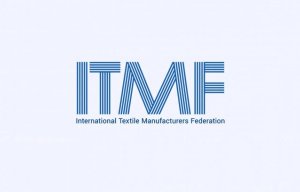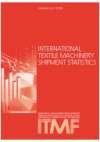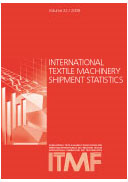
Mixed results for 2024 textile machinery shipments
The steep reduction in global shipments of new textile machinery in 2008 following a strong investment period between 2003 and 2007 continued in 2009 in most of the segments. Compared to 2008 shipments of spinning machinery were down by -17% (short-staple spindles) and -26% (open-end rotors), of weaving machinery (shuttle-less looms) by -3% and of flat knitting machinery (electronic) by -12%. On the other hand shipments of texturing spindles recorded an increase of +4

8th June 2010
Knitting Industry
|
Zurich
 The steep reduction in global shipments of new textile machinery in 2008 following a strong investment period between 2003 and 2007 continued in 2009 in most of the segments. Compared to 2008 shipments of spinning machinery were down by -17% (short-staple spindles) and -26% (open-end rotors), of weaving machinery (shuttle-less looms) by -3% and of flat knitting machinery (electronic) by -12%.
The steep reduction in global shipments of new textile machinery in 2008 following a strong investment period between 2003 and 2007 continued in 2009 in most of the segments. Compared to 2008 shipments of spinning machinery were down by -17% (short-staple spindles) and -26% (open-end rotors), of weaving machinery (shuttle-less looms) by -3% and of flat knitting machinery (electronic) by -12%.
On the other hand shipments of texturing spindles recorded an increase of +49% and that of circular knitting machines of +20%. The investment boom until 2007 which was closely related to China’s integration into the WTO structures and the phasing-out at the end of 2008 of the traditional quota-regime under the WTO-Agreement on Textiles and Clothing (ATC) came to an abrupt end in 2008 both for cyclical reasons as well as a result of the global financial and economic crisis.
These are the main results of the 32nd annual International Textile Machinery Shipment Statistics (ITMSS) recently released by the International Textile Manufacturers Federation (ITMF). The report covers six types of textile machinery, namely spinning, texturing, weaving, large circular knitting, flat knitting and finishing machinery. The 2009 survey has been compiled in cooperation with some 112 textile machinery manufacturers, representing a comprehensive measure of world production.
The segment of circular knitting machines recorded an increase of +20% to 25,450 in comparison to 2008. This was the fourth highest level since the year 2000 and considerably higher than pre-2004 period (around 11,000). With 85%, Asia was the preferred region of investments in circular knitting machines. Like in the other segments the biggest investor in this type of knitting machinery was China with 17,600 or 69% of global shipments. Mauritius was the second biggest investor in 2009 with 2,300 machines or 9% of global shipments followed by Bangladesh as distant third with 840 machines or 3.5%, India with 570 or 2%, Brazil with 540 or 2% and Korea Republic with 360 or 1.5%.
The decrease of global shipments of textile machinery was less pronounced in the segment of electronic flat knitting machines. Global shipments in 2009 were down by -12% to 17,840. The bulk of shipments went to Asia (90%) with Europe (including Turkey) absorbing 9%. Once more China was the biggest single investor in electronic flat knitting machines receiving 10,690 machines (60%) followed by Hong Kong with 4,320 (24%), Italy with 900 (5%), Turkey with 470 (3%) and Cambodia with 200 (1%).
Following a considerable drop in shipments of short-staple spindles in 2008 (-33%) shipments continued to fall by another -17% in 2009. Compared to 2007 global shipments plummeted until 2009 by -44% to 7.2 million spindles. Nevertheless, this is still well above the pre-investment boom levels when shipments reached around 3.7 million spindles. By far the largest part of this new machinery was destined for Asia (7.0 million or 97%). China alone absorbed 5.04 million or 70% of global shipments, followed by India (1.37 million or 19%), Vietnam (111,000 or 1.5%), Bangladesh (108,000 or 1.5%), Myanmar (89,000 or 1.2%), Turkey (85,000 or 1.2%) and Turkmenistan (82,000 or 1.1%).
Global shipments of long-staple (wool-) spindles plummeted in 2009 by -78% to only 32,000. Shipments to Asia decreased by -85% to 16’800. Also shipments to Europe (incl. Turkey) fell by -43% to 10,600 as well as to South America where shipments fell by -30% to 4,600. Like in 2008 there were no shipments in 2009 to Africa. Also North America did not receive any long-staple spindles in 2009 (2008: 2,500).
After an exceptional sky-rocketing increase in 2007 to 576,000 (+64% compared to 2006), investments in open-end rotors plummeted in 2008 by -66% to 195,650 and continued to do so in 2009 to merely 144,500 (-26%). With 120,300 rotors or 83% Asia was again the main recipient of open-end rotors in 2009. With 79,000 China’s global share reached 55% followed by India as a distant second with 9% or 12,600, Brazil with 8% or 11,500 and Kazakhstan with 4% or 6,400 and Indonesia with 4% or 6,100.
Shipments of single heater draw-texturing spindles (for polyamide filaments) fell by -45% to 2,880 in 2009. Only China (2,640 or 92%) and Korea (240 or 8%) invested in this type of texturing machinery.
The amount of shipped double heater draw-texturing spindles (for polyester filament) jumped by +52% to 248,000 back to the levels of 2007 and 2006. The installations of new machinery were nevertheless considerably below the record highs in 2004 (406,000) and 2005 (315,000) but still higher than those at the beginning of the decade (2000: 138,000). By far the biggest and all-dominating investor was again China with 139,000 new spindles or 56% of global investment followed by India with 41,500 or 17%, Thailand with 16,300 or 7%, Brazil with 10,500 or 4% and Russia with 3,200 or 1.5%.
Investments in shuttle-less looms dropped in 2009 by -3.0% to 43,400 machines marking the lowest investment level since the year 2000, the year when shipments of Chinese textile machinery manufacturers were included for the first time in this survey. 41,750 or 96% of all machines went to Asia. Country-wise China was again by far the biggest recipient of shuttle-less looms having installed 25,600 or 59% of total shipments in 2009. With 8,400 (or 19%) and 3,450 (or 8%), respectively, Bangladesh and India were distant second and third, followed by Indonesia with 1,760 or 4% and Vietnam with 750 or 2%.
The 2009 edition of the ITMF international textile machinery shipment statistics includes for the fifth time data on finishing machinery.
Further information on the 32nd annual International Textile Machinery Shipment Statistics (ITMSS)

Business intelligence for the fibre, textiles and apparel industries: technologies, innovations, markets, investments, trade policy, sourcing, strategy...
Find out more